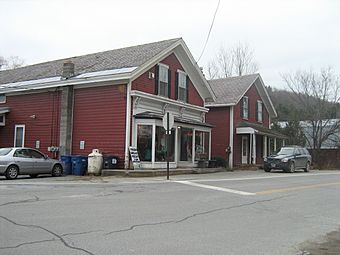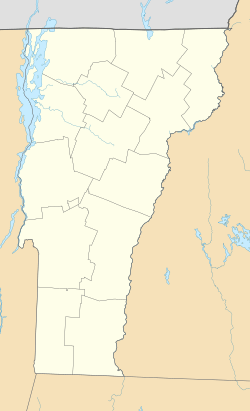Charlotte Center Historic District facts for kids
Quick facts for kids |
|
|
Charlotte Center Historic District
|
|
 |
|
| Location | Church Hill and Hinesburg Rds., Charlotte, Vermont |
|---|---|
| Area | 27 acres (11 ha) |
| Built | 1790 |
| Architect | Multiple |
| Architectural style | Mid 19th Century Revival, Late Victorian |
| NRHP reference No. | 84003460 |
| Added to NRHP | July 19, 1984 |
The Charlotte Center Historic District is a special area in Charlotte, Vermont. It's like stepping back in time to the 1800s! This historic district shows us what the town center looked like long ago. It has old homes, public buildings, and shops.
The area was first settled around 1790. Most of its buildings were built in the mid-1800s. The district was added to the National Register of Historic Places in 1984. This means it's recognized as an important historical site.
Contents
Discovering Charlotte Center
The town of Charlotte was officially created in 1762. But people didn't start settling there until about 1784. This was after the American Revolutionary War ended.
Local stories say that a marker was placed at the town's exact center. That's where the village of Charlotte Center grew up. It was located on the main north-south road of the time. This old road is now different from the modern United States Route 7.
A Stop on the Stagecoach Route
Charlotte Center became an important stop for travelers. It was on the stagecoach route between Burlington and Troy, New York. A stagecoach was like an old-fashioned bus pulled by horses.
The village's first settler was Hezekiah Barnes. He built a tavern in 1800. A tavern was a place where travelers could eat, drink, and sleep. This made Charlotte Center a busy spot.
Changes in the Town Center
Charlotte Center was the main area for businesses and town activities for many years. But things changed when the Central Vermont Railroad was built. The railroad didn't go through Charlotte Center.
Instead, the train station was built at a place called Charlotte Four Corners. Because of this, many businesses and political activities moved there. Charlotte Center became quieter, keeping its old-time feel.
Buildings and History of the District
The historic district stretches along Church Hill Road. This road used to be the stagecoach route and part of US 7. It starts where Church Hill Road meets Hinesburg Road.
Key Buildings to See
Two important buildings stand out in the district:
- The Congregational Church: This church was built in 1854. It's designed in the Greek Revival style, which was popular back then.
- The former Town Hall: Built in 1850, this building used to be where town meetings were held. Now, it's a local museum.
Most of the buildings in the district are made of wood. They were built before 1860. There is only one stone house in the area. Hezekiah Barnes, the first settler, built this stone house around 1790. It's a Cape style house, located near where his old tavern used to be. The tavern is gone now, but its spot is marked.
The district also includes several old barns. Some of these barns were built in the early 1900s. One barn is even thought to have been built by Hezekiah Barnes around the same time as his stone house. These buildings help us understand what life was like in Charlotte Center long ago.



